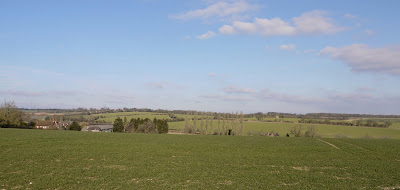Snowdrops near Dummer
A lovely Sunday for a walk and today Ange joined me on the Wayfarer's Walk: we took two cars and did a linear walk for a change.
We started by walking across fields and then following the edge of South Wood to cross the busy A30 and pass through the edge of Peak Copse to reach the even busier M3. The snowdrops above were in a small copse just by the bridge over the motorway.
On the other side we followed the motorway for a short way then turned left on the road into the pretty village of Dummer. As we approached, we were struck by how many people were scattered across two large fields, one on either side of the road. We eventually realised that they were members of the Dummer Metal Detection Society - presumably the local farmer was having an open day for them.
At the south end of the village lies the 12th century church of All Saints.
As is normal, the most substantial old parts are the chancel and chancel arch, which date from about 1200 (Pevsner). In front of the chancel arch is a remarkable rood canopy dating from the 15th century. This picture is taken looking up at the ceiling (the canopy would have stood over the cross). The timber framed roof of the nave and the belfry are also 15th century
Other features of the church reflect the inevitable late Victorian restoration e.g. the rather nice glass in the east window by Kempe.
Next to the church is the large, but not beautiful Dummer House, in white stucco with a large pediment. Unusually Pevsner gives no date. And opposite the church is the imposing Victorian rectory.
We now headed on a zig-zagging southerly route along farm tracks through fields to pass Dummer Grange and then walk along its drive to reach the road where we shortly stopped - at Breach Farm Cottages.
Conditions: blue sky and sunshine
Forward distance: 5 miles; distance now traveled 26.5 miles.
Map: Explorer 144 (Basingstoke, Alton and Whitchurch)
Rating: three stars. Modest changes of level, farmland with no real views. Dummer made a nice focal point.
Reflections
Rather shockingly, I managed to leave my walking haversack at home: no camera, no binoculars, no water, no emergency knee bandage. What a muppet! Perhaps fortunately, there were not too many photo opportunities - the few pictures were taken on my iPhone, which at least confirms the value of having a proper camera!
















































